Faster. Stronger. Greener.
After the World Anti-Doping Agency removed hemp-derived CBD from its prohibited substances list in 2018, more and more athletes are trying it. Here are stories from five elite competitors who say it's given them an edge.
You’re about to meet five extreme athletes who faced extreme challenges—chronic pain, multiple surgeries, dependence on prescription medications, a broken neck, and the one that eventually humbles us all, age. But each athlete was open-minded enough to adopt cannabidiol (CBD) into their health-and-training regimens. And now all five claim it’s giving them a competitive edge.
“In my 15 years of managing athletes, I haven’t seen a category like CBD ever,” says Frank Vatterott, founder of the Human Interest Group, a sports marketing and business development firm in Boulder, Colorado. “It’s exploding.”
But athletes are hesitant about admitting they use it. In fact, this is the first time some of these athletes have spoken publicly about their CBD use. Although it’s no longer a banned substance, there’s still controversy and stigma surrounding it. Keep in mind, however, that four of our featured athletes are sponsored by iKOR Labs, which manufactures and sells CBD products, and the other one heads a research and consulting firm that advises on its use. So they don’t just use CBD, they work for it as well. An endorsement deal with Advil would no doubt pay better, but they’ve made their green choice. When you’re at the elite level of sport (or in one case, an elite level of chronic pain), your patience with placebo, and especially anything with negative effects, is short.
Also important to note is that among the athletes who are still competing, it’s CBD not THC they’re using. The latter is the psychoactive compound in marijuana that makes people high. While there’s some evidence that CBD and THC work best together, especially for pain relief, the latter is still banned by WADA and therefore not an option for them.
And finally, although the science on CBD and athletic performance is limited and the effects you’re about to hear are purely anecdotal, two of our featured athletes are scientists—one a neurologist and the other an epidemiologist—who’ve made lab rats of themselves. After reading about their experiences and hearing their advice, maybe you’ll decide to experiment, too.
The Game Changer
After injuries ended her marathon career, 40-year-old Leah Thorvilson became a pro cyclist and quit her meds—with the help of CBD.
She was disappointed by her performance in the 2012 Olympic marathon trials. But rather than giving up, Leah Thorvilson doubled down, finishing eight marathons and a 50-mile ultra within four months. But the stress led to a hamstring tear, knee damage, and four surgeries over the next four years.
“I ended up with cadaver bone in my femur because it was so eroded,” says the Little Rock, Arkansas, resident. “It led to a meltdown moment for me because who am I, if not a runner?”
On top of the physical challenges, there were emotional ones: A training partner died in an ATV accident, her best friend’s mother was kidnapped and murdered, the wife of a track coach at the college where she worked committed suicide, and a prominent local runner died of a heart attack during a marathon. “All of this happened in three to four months of 2014,” she recalls, “and it was way too much.”
Thorvilson began taking an anti-anxiety medication in addition to the Ambien she had been popping nightly since 2012 in an effort to deal with her insomnia. After her final surgery in 2015, under doctor’s orders to avoid high-impact activity for a year, she realized she had to do something or risk losing her mind.
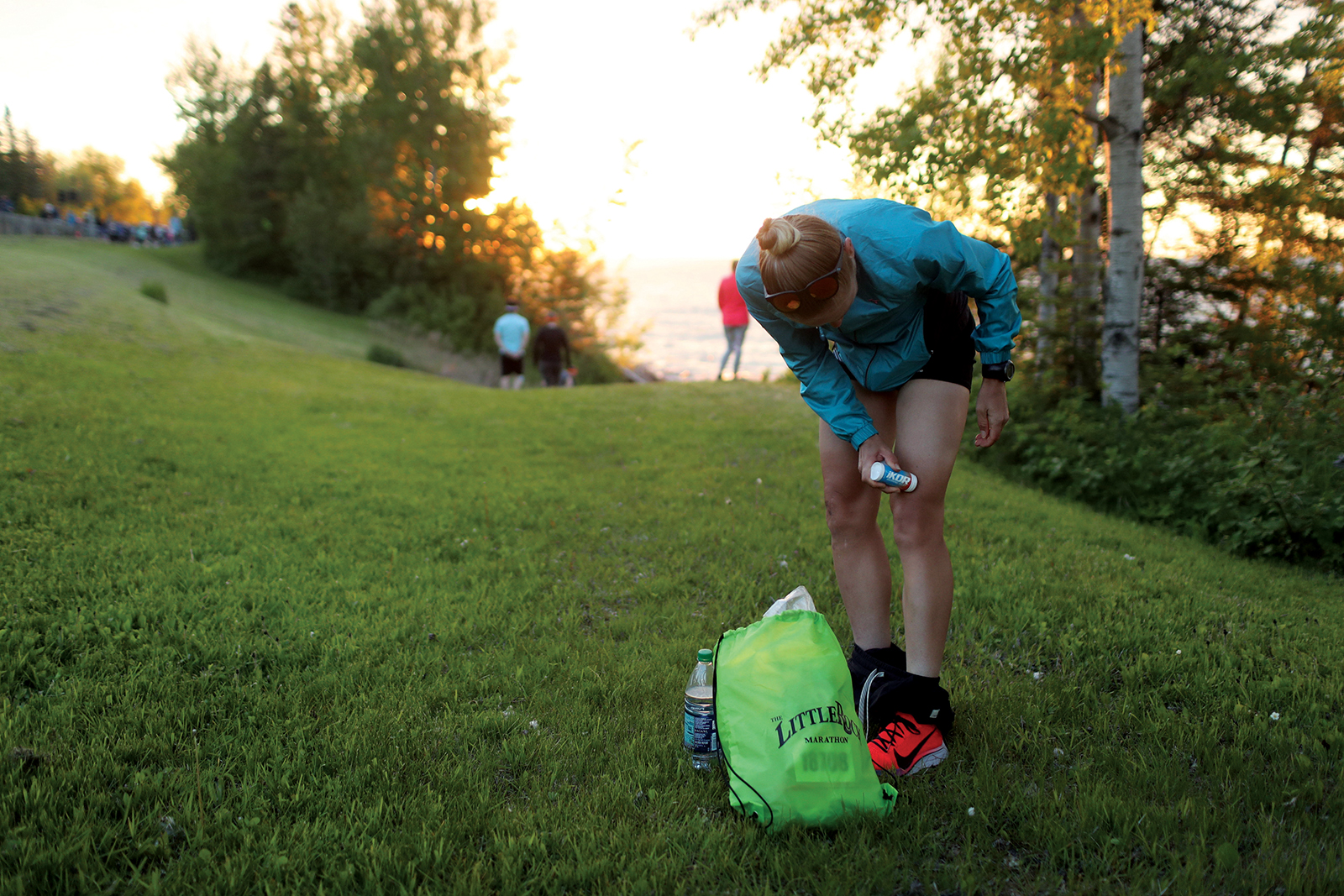
Elite runner-turned-cyclist Leah Thorvilson uses CBD to help her recover from intense training. She begins her post-race regimen with a warming roll-on.
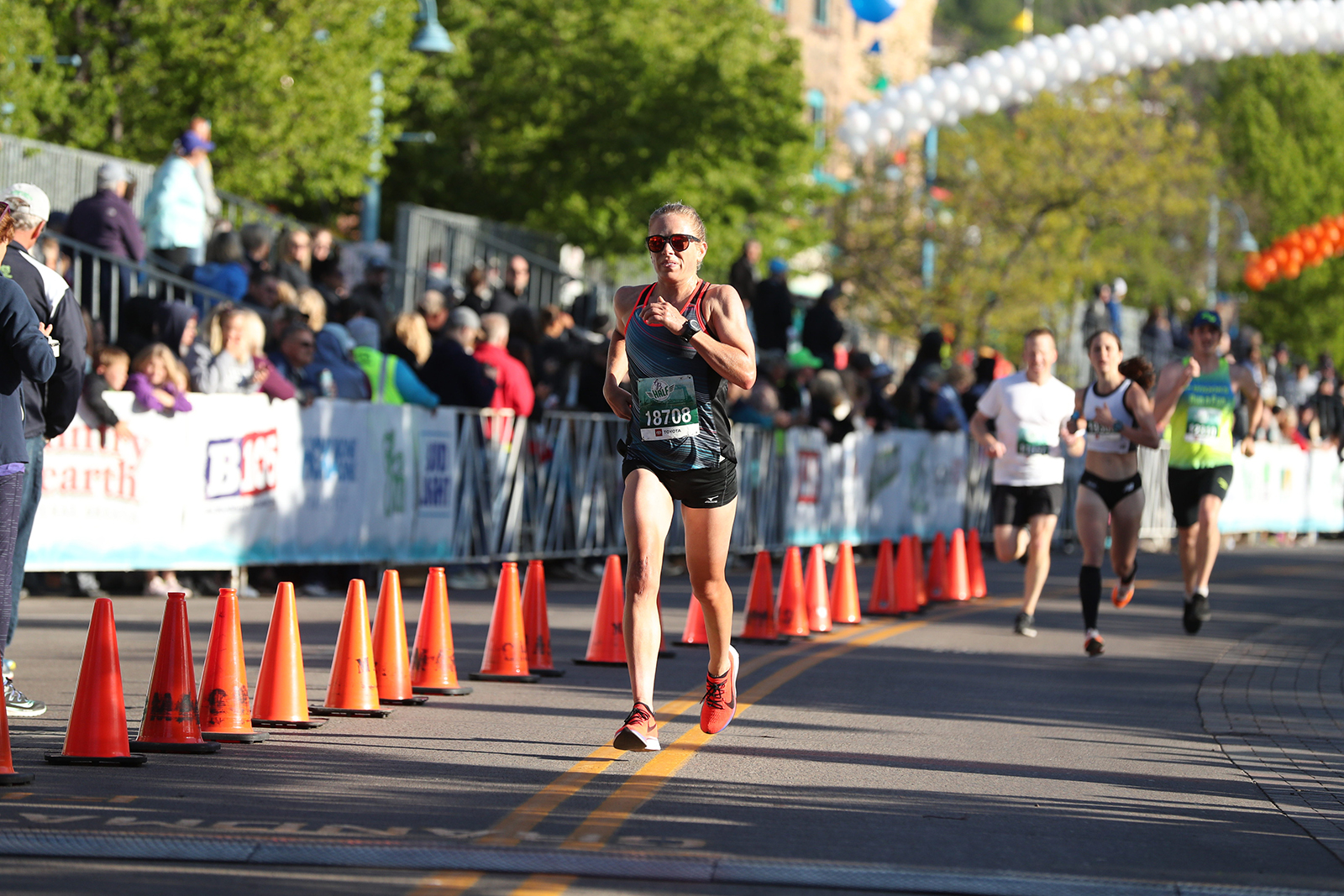
Elite runner-turned-cyclist Leah Thorvilson uses CBD to help her recover from intense training. She begins her post-race regimen with a warming roll-on.
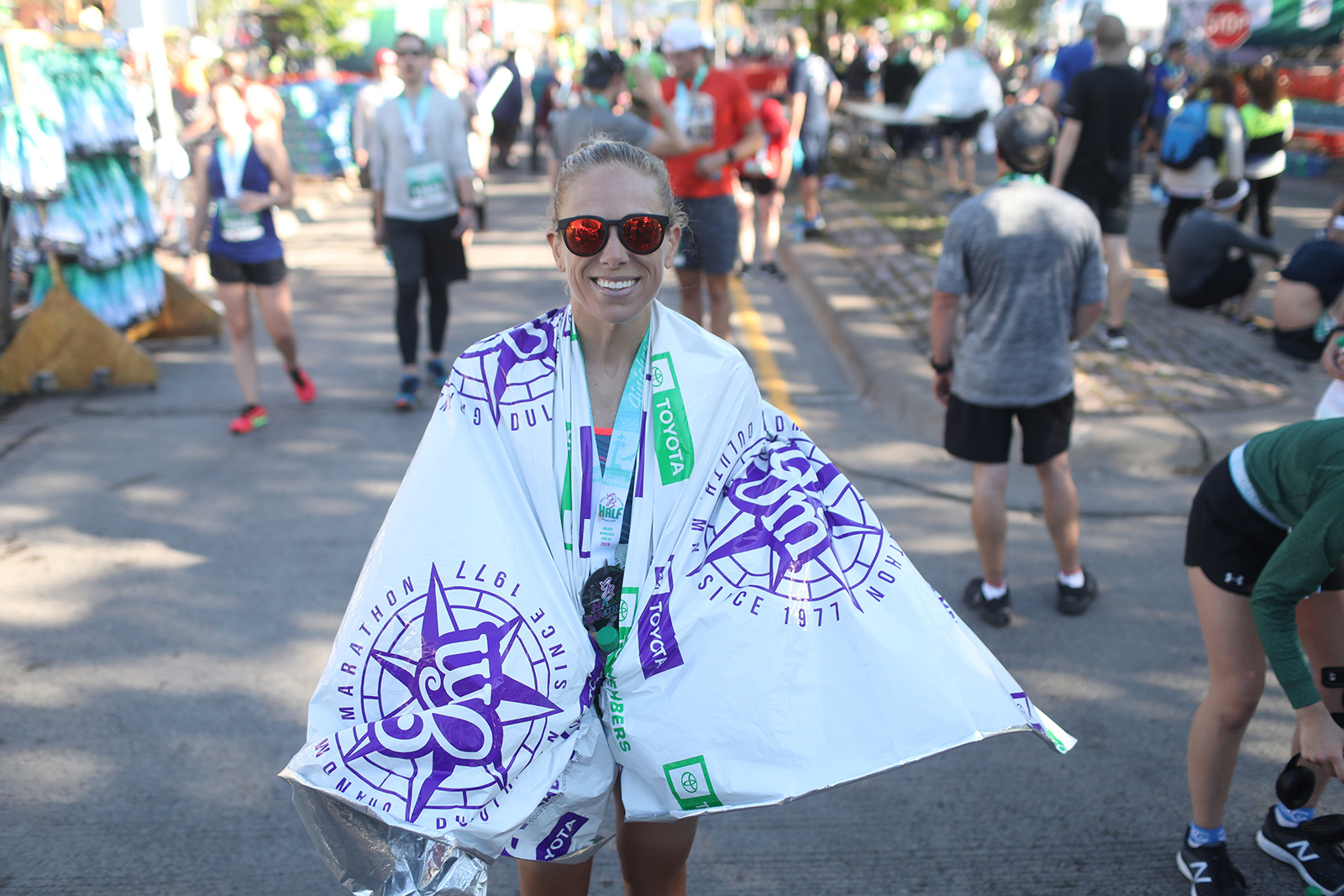
Elite runner-turned-cyclist Leah Thorvilson uses CBD to help her recover from intense training. She begins her post-race regimen with a warming roll-on.
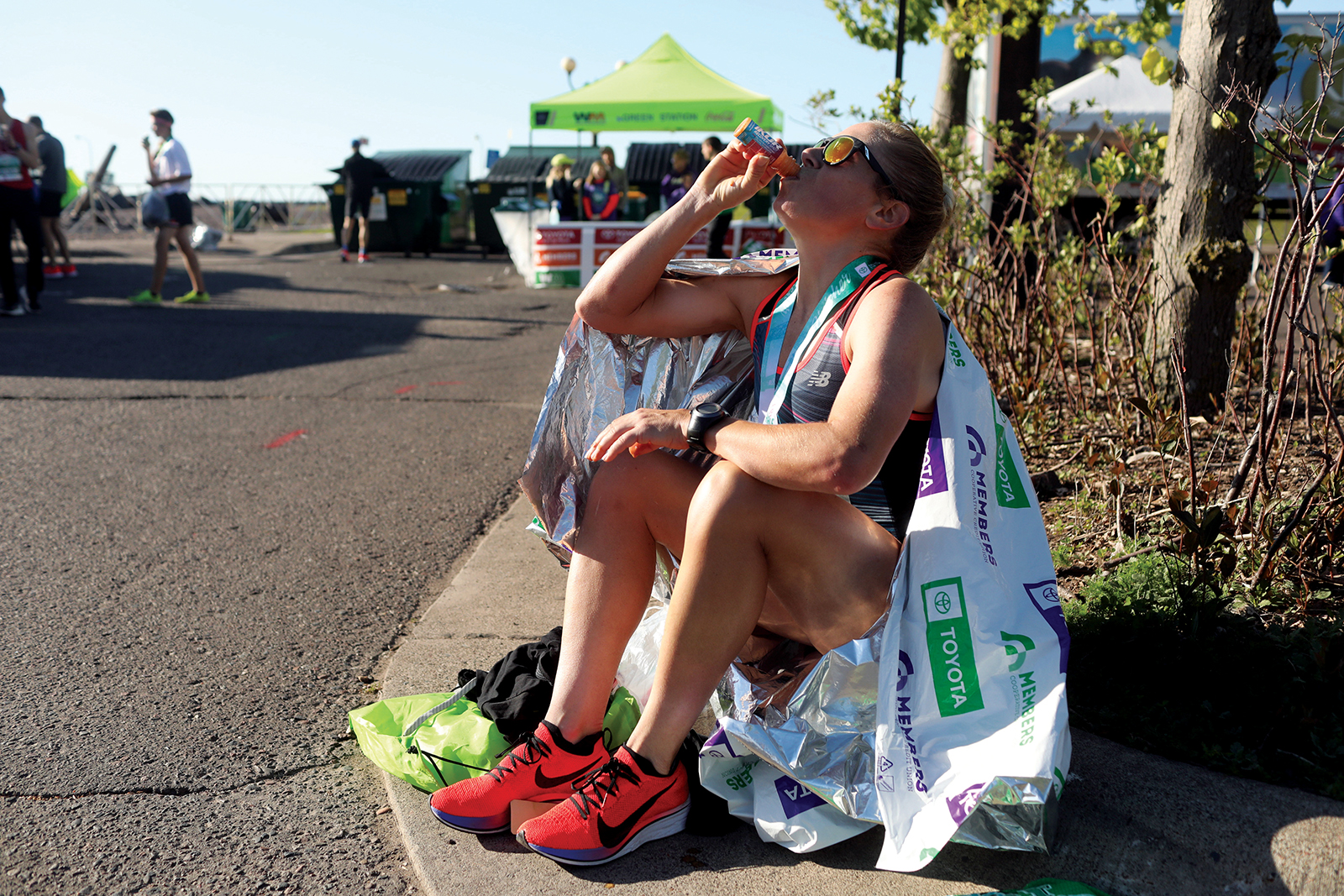
Elite runner-turned-cyclist Leah Thorvilson uses CBD to help her recover from intense training. She begins her post-race regimen with a warming roll-on.
Relief came from two unexpected sources: cycling and CBD. A friend recommended a virtual riding platform called Zwift, which simulates outdoor cycling and racing on a stationary trainer. She got hooked and entered a Zwift competition that awarded a pro contract to the winner.
“Never in a million years did I think it would be me,” she says. “I’d only owned a bike for three months.” But she beat the competition and joined the Canyon/SRAM pro team in Europe for the 2017 racing season.
As this second career accelerated, Thorvilson reconnected with a friend developing CBD products for athletes. Because CBD is reputed to help with anxiety and recovery (and was no longer banned), she tried it. Thorvilson began with five squirts of the hemp extract iKOR Daily under her tongue morning and evening (50mg CBD). After experiencing no negative effects, she upped that to eight squirts twice daily (80mg CBD), with an occasional extra squirt (5mg) after hard training sessions, races, or when fighting a cold. She rubs iKOR’s Warming Relief topical hemp extract (125mg CBD) into her legs as needed and also takes the company’s new Recovery Shot (13mg CBD) after races to reduce inflammation.
“Do I get the same sleep benefit from CBD? Well no, Ambien is quite strong,” she explains. “But I was worried about Ambien’s long-term effects, and CBD helps me sleep most nights. Same with anxiety; it’s not like ‘Wow, this stuff is amazing!’ It’s more like ‘maybe this is helping, and it’s certainly not hurting, so I’ll continue.’”
Thorvilson says she’s seen the best effects with muscle recovery. She rubs iKOR’s Warming Relief topical hemp extract into her legs as needed and also takes the company’s new Recovery Shot after races to reduce inflammation. “I’ve made no other changes to my training that would help me recover faster,” says Thorvilson, who now rides for Eastern Overland and is sponsored by iKOR, “and being 40 years old I naturally recover more slowly.”
“Overall, I don’t see any reason to be afraid of CBD,” she adds. “My best results have been very good, and my worst results have been neutral, so it seems harmless.” But she cautions, “Just because I was able to get off my medication doesn’t mean you should replace yours with it. CBD is just another avenue to explore with your doctor.”
The Explorer
Hillary Allen was one of the world’s best sky-runners—until she fell back to earth. Now, with the help of CBD, she’s soaring again.
As the daughter of scientists, Allen naturally followed that life path—earning degrees in chemistry, neuroscience, and structural biology while also becoming an elite ultra mountain runner (a pursuit nearly as technical and exploratory as her fields of study). So when she discusses the effects of CBD, either casually among friends or with students at Front Range Community College in Longmont, Colorado, where she teaches, her opinions automatically get more credence.
“I’m a scientist first, that’s how my mind works,” she says, “When considering something new I read about it and get a feel for it. This is true for me taking new vitamins or supplements, or trying new workouts. I do research and draw my own conclusions before moving forward.”
Actually, the 30-year-old Allen is fortunate to be moving forward at all. While running a 50K sky-race (along mountain ridges) in Norway in 2017, she slipped and fell 150 feet off a rocky precipice. She broke 12 bones and eventually underwent five surgeries. For someone who had previously called pain “my training tool,” who willingly submersed herself in it daily, who constantly flirted with the edge it represents between strength and injury, this setback was new ground. Her pain was so intense, so unrelenting, she even sought relief in morphine and opioids.
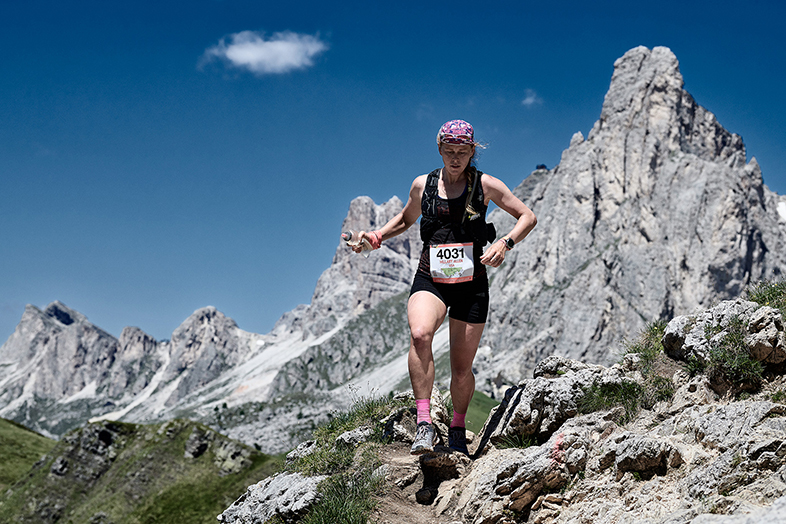
Mountain runner Hillary Allen overcame 12 broken bones and five surgeries from a 150-foot fall—and then weaned herself from opioids—with the help of CBD.
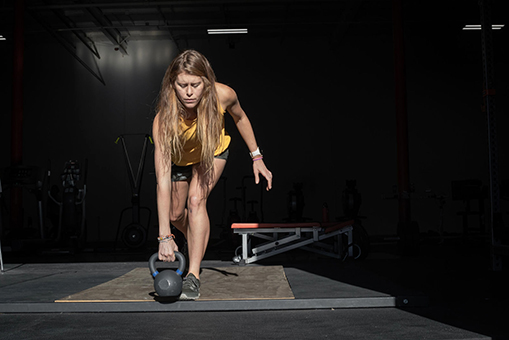
Not wanting to become dependent on those drugs and already familiar with the chemistry of cannabinoids, she began using CBD both topically and orally. “Because of my science background, I never felt apprehensive about trying it,” she says. “I knew CBD doesn’t get you high, and that it’s been used to treat overactive nerves in diseases like fibromyalgia to reduce pain. There is also significant data supporting its benefits in improving sleep and mood and reducing inflammation—all things I needed to recover. So I was optimistic, and if you think something will have a positive influence it usually does.”
Allen started taking a few squirts (5mg CBD per squirt) of hemp extract under her tongue before bed and also rubbing some of it on her skin where it hurt. “I noticed the oral CBD helped me sleep more soundly, and the topical treatment helped reduce my nerve pain.” She has continued that oral regimen, although now she also uses a few swipes of iKOR’s Warming Relief in the stick form (125mg CBD per stick; it also contains olive oil, beeswax, shea butter, peppermint, and cayenne).
Just nine months after her fall, Allen completed a six-hour, 27-mile run up Pikes Peak. Amazingly, she returned to racing only a month after that. And these days she’s dabbling in ultra-cycling races on gravel.
Allen doesn’t credit CBD alone for her recovery from injury and her continuing high level of performance. But she is convinced of its value as one component in a multi-faceted health-and-fitness plan.
“It’s never just one thing,” she says, “it’s a combination of resources.”
The Age Defier
As a five-time Ironman world champ, Craig Alexander is one of the fittest human beings on earth. At age 46, he uses CBD to stay competitive.
Even more impressive than Craig Alexander’s triathlon resumé is his continued appearance atop podiums worldwide, even at an age when most other Ironmen have retired. Indeed, the first question that pops into your mind when meeting him—he of model good looks, charming Aussie accent, and aerodynamic 5-foot-9, 150-pound frame—is, how does he do it?
The Wonder from Down Under is ageless.
Crowie, as he’s called, professes five pillars to being an Ironman, and they’re as applicable to life as they are to triathlon: 1) balance, 2) consistency, 3) endurance, 4) adaptability, and 5) recovery. The fact that recovery comes last in that list doesn’t mean it’s the least important. Rather, for him, it’s what underlies all the others and makes his apparent agelessness possible.
“Recovery is the most overlooked thing in sport,” he says. “You can’t have great training consistency unless you recover well. Successful training incorporates a spectrum of intensity, from full-throttle workouts to rest and recovery. It’s the valleys that make the peaks possible.”
Alexander, who has a reputation for relentless conditioning, didn’t always appreciate this. But as he’s gotten older, he noticed physical changes in his body—drops in strength and speed and his ability to rebound quickly from hard knocks. He’s reduced his training mileage and intensity significantly in the last few years while looking for any new competitive edge—and he found one in CBD.
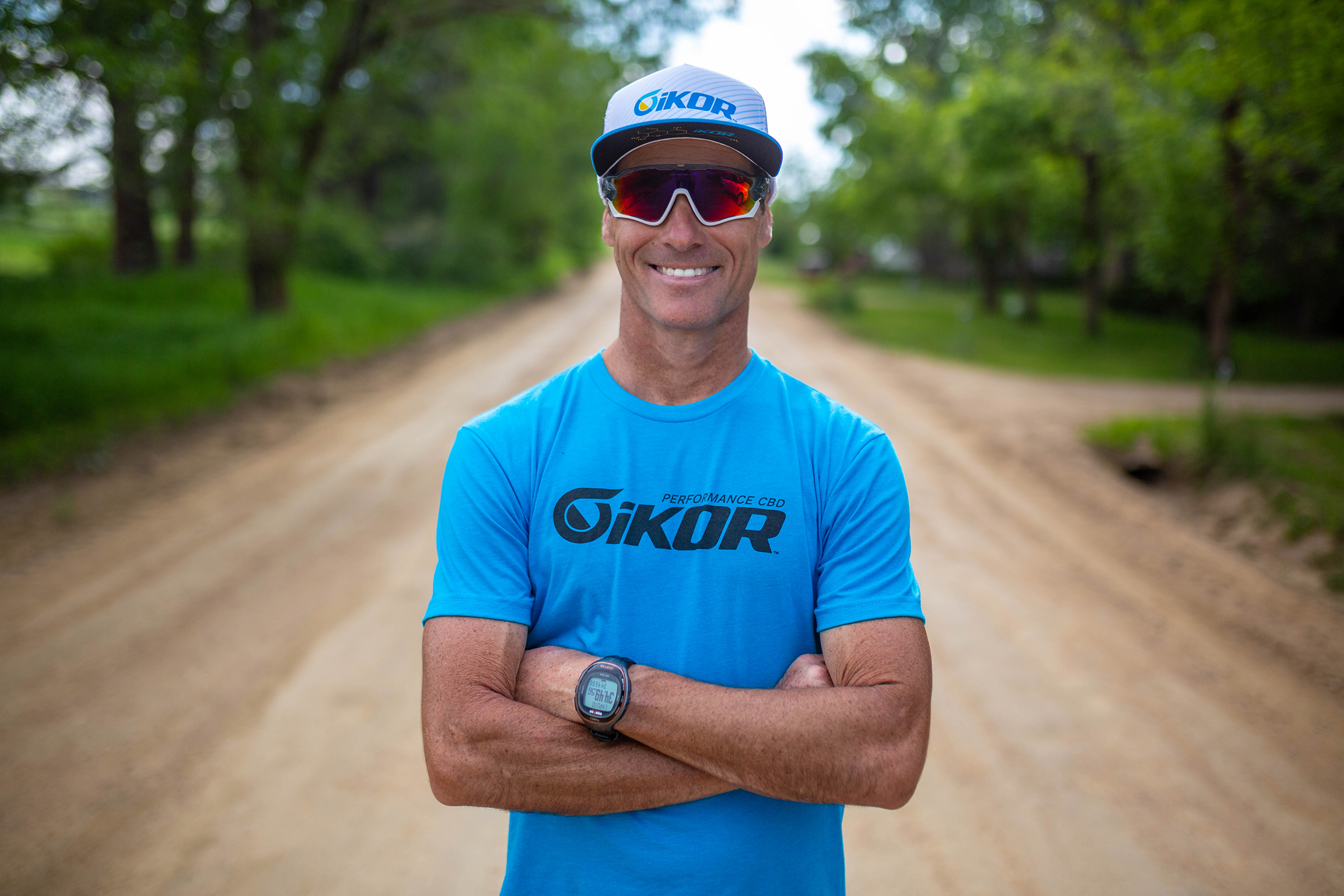
“I try to stay up-to-date with the latest research on anything performance-related,” he explains, “and I’d been reading about the effects of CBD. I was also intrigued by its general quality-of-life benefits. And then I heard about it more specifically from a friend who was investigating it for his daughter, who had ALS.”
After making sure the particular brand of CBD he was considering (iKOR Daily) met WADA standards, he started taking 5 squirts every morning and evening in early 2018 (50mg CBD total per day). Of late, he’s also added iKOR’s topical Warming Relief (125mg CBD) to the mix, which, he says, “has been good for targeting specific areas of soreness.”
Alexander has always been open-minded about trying new things. Over the years, he’s used protein shakes, caffeine, ice baths, and dry needling to tweak performance.
“After about a week of taking CBD, I definitely felt I was recovering much better from training,” he says. “I didn’t have as much post-training soreness, and I also felt I was sleeping better and deeper.”
These effects have continued, and he’s made CBD a regular part of his fitness regimen. In fact, when he forgot to pack his supply for a recent 10-day trip, “I noticed a difference in sleeping, post-training recovery, and dealing with jet lag.”
Of late, he’s also added a topical CBD anti-inflammatory to the mix, which, he says, “has been good for targeting specific areas of soreness.”
Although some athletes contend CBD also aids mental alertness and toughness, Alexander can’t say that’s definitively been the case with him. “There’s no question, though, that I still have an appetite for hard, painful training and racing.”
If you’re considering trying CBD and are a high-level athlete, Crowie says to first make sure it meets WADA requirements. Then just go for it. “Anything that can enhance sleep and counteract or minimize the inflammatory processes caused by training is going to be a huge benefit,” he says.
The Comeback King
Tim Don made one of the most unbelievable and inspirational comebacks in athletic history—and one of the things that made it possible was CBD.
Imagine this: You are in the best shape of your life, having just crushed the Ironman world record by more than 4 minutes (7:40:23). A few months later you’re in Kona for the 2017 Ironman World Championships, one of the favorites to win. But three days before the race, out for a spin on your bike, you’re hit by a truck and break your neck. Suddenly, instead of a medal around your neck, you’re wearing a metal halo brace. It takes four screws, sunk into your skull, to keep the halo and your upper spine in place. Although everyone is optimistic and encouraging, deep down they (you?) know even Ironmen don’t return from this.
But somehow you do. You secretly start going to the gym. Three months later the halo comes off. The holes in your head heal. In April you enter the Boston Marathon and run a 2:49:42. And six months after that you return to Kona and finish 53rd out of 2,000-plus competitors in 8:45.
As you’re about to cross the finish line, someone yells, “You’re a hero, man.”
The man is Tim Don. To look at him—just 5-foot-8, 143 pounds—you’d never expect there was so much strength, fortitude and pure junkyard-doggedness in there. But his is among the most ferocious comebacks ever. And the 41-year-old Brit achieved it all without losing his trademark grace and wit.
CBD helped Don’s comeback. Although he wasn’t introduced to it until after the worst of the pain from the accident had subsided, he contends it played a role. “I’ve been a consistent user of CBD tincture for the past 18 months—five squirts of iKOR Daily in the morning and five at night [for a total of 50mg CBD per day], and I’ve recently started using its Warming Relief rub,” he explains. “It definitely helps with inflammation from daily training, and I believe it helps with sleep as well, which is a key component to proper recovery.
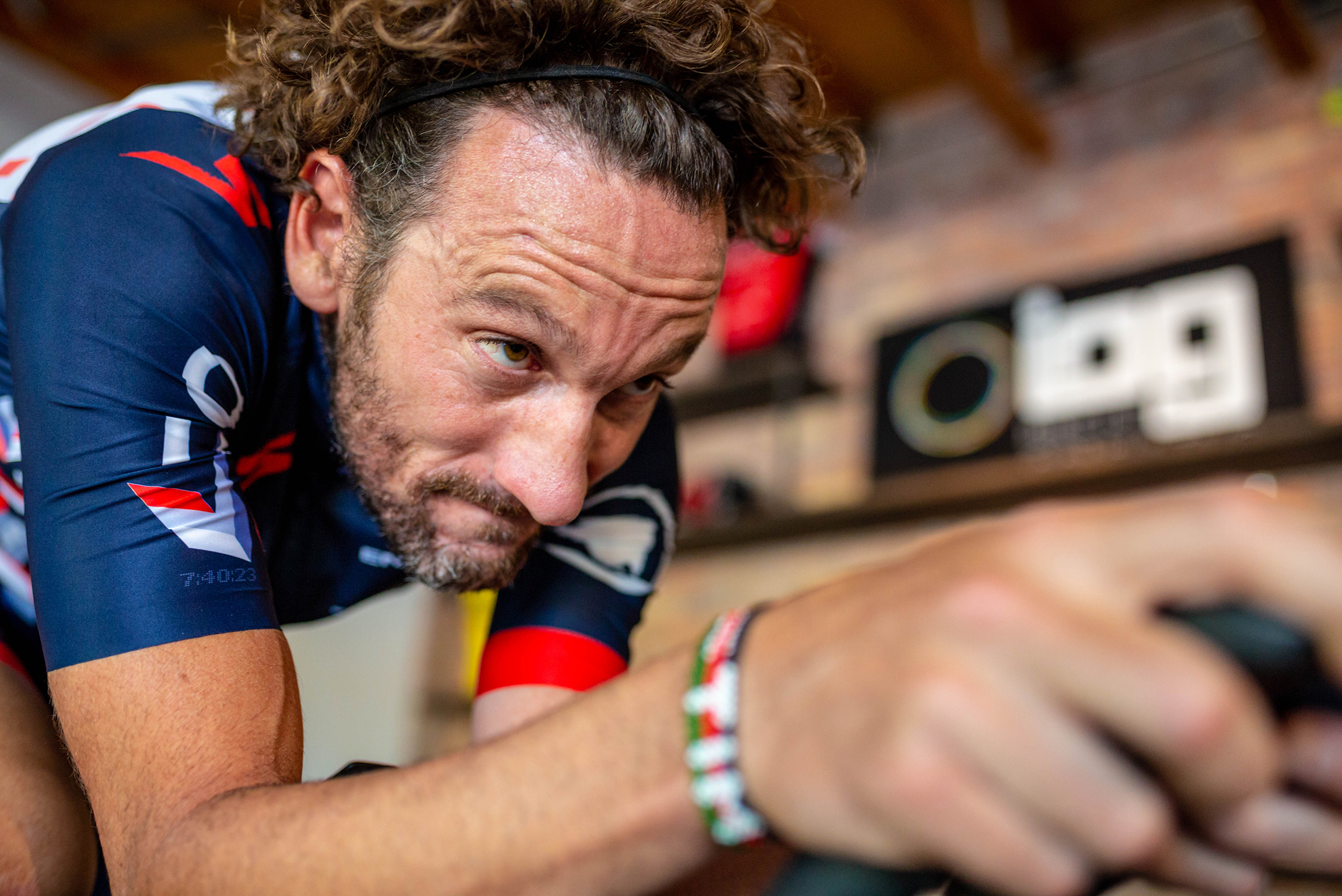
World record holder Tim Don made a triumphant return to Ironman racing after breaking his neck while training.
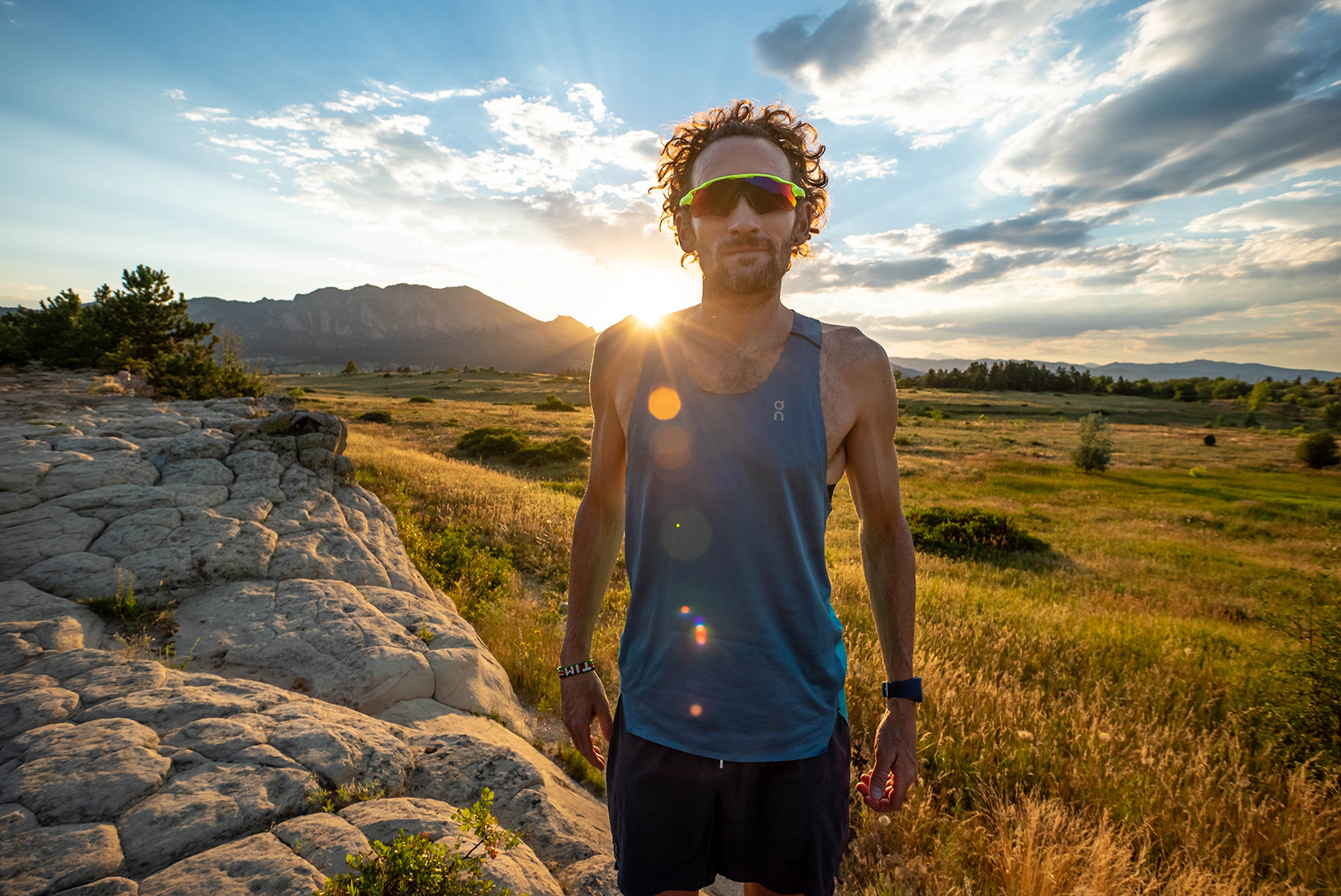
World record holder Tim Don made a triumphant return to Ironman racing after breaking his neck while training.
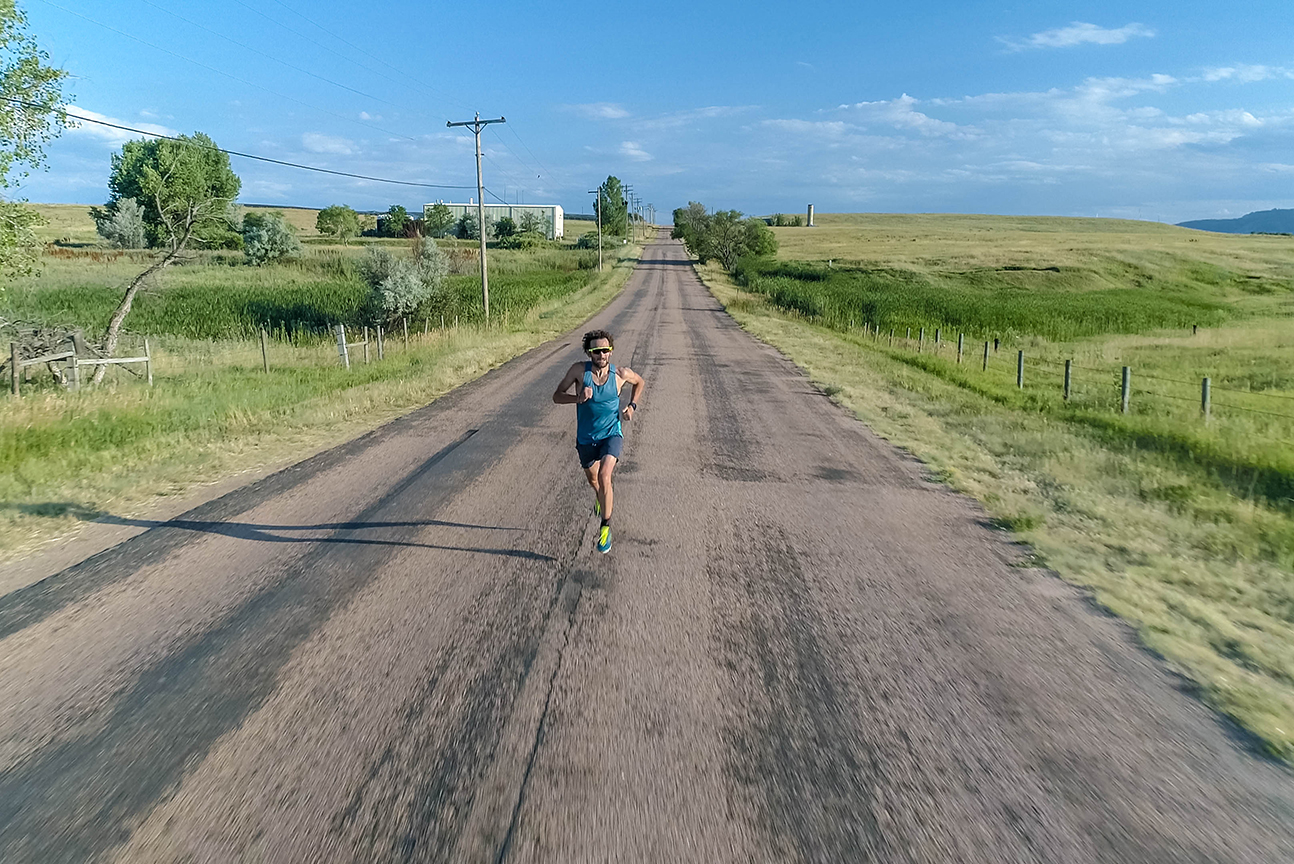
World record holder Tim Don made a triumphant return to Ironman racing after breaking his neck while training.
“There were many hills and valleys during the 2018 season—lots of psychological swings from being restricted with my training, to all the fitness I’d lost, to trying to qualify for Ironman World Champs. I think CBD played a solid role during that rollercoaster. Good training is about consistency. Consistency relies on good recovery. So bottom line: CBD is one of many tools I used to train at my best possible level.”
Like other elite athletes, Don admits to being hesitant about trying it. “When my managers suggested it, I didn’t really know anything about CBD,” he says. “There is also the stigma and connection with other cannabis products that naturally made me apprehensive. As a professional athlete I’m cautious about what I put in my body. But I’m also always looking for that edge, and recovering more effectively is a great edge.”
As Don works to return to Kona this fall, he’s encouraging other athletes to experiment with CBD, but only after doing their homework on brands and products. “Keep in mind that despite all the hype and excitement about what CBD can do, it’s an unregulated market with a very broad range of quality.”
And when it comes to setting goals and achieving the impossible? “Remember that the best goals are the ones that are a bit crazy,” he says. “To an elite athlete, that’s what drives us. It is doing what people say we can’t, it is pushing our bodies to the max. I don’t want to ever stop and say: Well I could have, I should have, I would have, so why didn’t I? I’d rather reach for something that’s very high because you know what they say: When you reach for the stars, you might not make it, but you’ll still be in heaven.”
Imagine that.
The Experimenter
Joanna Zeiger, Ph.D. started using CBD and THC for chronic pain after a freak accident ended her Ironman career. Now she’s researching—and demonstrating—
the benefits of both.
In a flat voice wrung dry of emotion by the subsequent years, Joanna Zeiger recounts the moment that changed her life: “I was defending my title at the 2009 Ironman 70.3 World Championships in Clearwater, Florida. At mile 45 of the bike ride, I grabbed a water bottle at an aid station but the person handing it to me didn’t let go. I flipped over the handlebar, broke my collarbone, and damaged my rib cage. The collarbone was repaired a few days later, but I’ve had nine surgeries on my ribs to correct the anatomic and nerve damage.”
Zeiger eventually had to quit triathlon—a bitter career end for the 2000 Triathlete of the Year and former Olympian. Although she was able to return to running and even qualify for the 2011 Olympic Marathon Trials, the pain persisted. “I was prescribed muscle relaxants, low-dose antidepressants, opioids…. It’s a long list of things I’ve tried.”
But there was one thing she resisted: cannabis. In her dozen years as a pro triathlete, it was illegal in all forms so she never considered it. And as a drug-abuse researcher at the University of Colorado, she became convinced marijuana was dangerous. But then came the accident and the pain. Always the pain. Her husband, a medical doctor, encouraged her to try cannabis, and when it became legal in Colorado in 2014, she finally did.

“I walked into a dispensary, told them what was going on, and got a patch to put on my leg for the pain and some gummies for sleep. Only they never told me to cut the patch in pieces, and I got so high I couldn’t stand. I did get a decent night’s sleep, though, which gave me the notion that maybe I could find better well-being with proper dosing.”
Zeiger, who studied genetic epidemiology at Johns Hopkins, started experimenting. She began with large doses of CBD (up to 100mg) but didn’t find it useful. Now she uses a 2:1 ratio of CBD to THC before/during/after exercise to mitigate muscle spasms that interfere with her breathing. If she needs quick pain relief, she vapes a 1:1 ratio.
Is cannabis her salvation?
“No,” she says, “because I don’t think anything is. But it definitely helps with sleep and muscle spasms. It also reduces the suffering that comes with pain, and that’s a big deal. Pain and suffering are different things. If I can reduce my suffering, I can go about my day more easily.”
Zeiger still takes over-the-counter and prescription pain relievers. But she says she’d be taking a lot more if it weren’t for cannabis. In fact, she’s been so impressed by the personal benefits that she’s made it her profession. With her father, Robert Zeiger M.D., PhD, she founded the Canna Research Group, with a mission of conducting comprehensive cannabis research from inception through publication to marketable results. Here’s her best advice for trying it:
• Define your goal: “This is the first thing to decide because it’s used in different ways for different things.”
• Consult a medical professional: Cannabis is a drug that can interact with other medications. Get expert guidance.
• Buy from a reputable source: “Get it from a dispensary or a company that does third-party testing or has a Certificate of Analysis [COA] on its website.”
• Start low/go slow: Begin with a low dose, monitor your reaction, and slowly add more if needed. For example, for pain relief start with CBD extract [5-10mg twice daily] and increase it weekly over 1-2 months until the pain lessens. If CBD extract alone doesn’t help, add THC [1-2.5mg] and slowly up the dose as needed.
“Start low/go slow, that’s the mantra in the world of cannabis,” she says.
Cannabis Use Among Athletes
The Canna Research Group recently surveyed 1,161 recreational-to-professional athletes. Most were triathletes, runners, and cyclists, but swimmers, hikers, skiers and yogis of all ages also responded. Here are the most significant findings:
26% of respondents used cannabis in the last two weeks
61% used it for pain relief
Top four reported benefits:
Improved sleep (71%)
• Less pain (69%)
• Calm (59%)
• Decreased anxiety (54%)
Top three reported adverse effects:
• Increased appetite (24%)
• Anxiety (21%)
• Difficulty concentrating (17%)
No adverse effects 55%
Dosing for Dummies
While compiling the definitive treatment guidebook The Cannabis Health Index, Uwe Blesching collated the dosages that people were using, and researchers were testing, to treat hundreds of conditions and bodily malfunctions. Here are the averages, based on a 165-pound person. These will give you and idea of where “start low” begins, and “go slow” yields to “pedal-to-the-metal.” Build up carefully, you hear?
THC Daily Dosages
Micro dose: 0.1 mg to 0.4 mg
Low dose: 0.5 mg to 5 mg
Medium dose: 6 mg to 20 mg
Higher dose: 21 mg to 50+mg
(For experienced medicinal users, a daily limit is 1,000+mg)